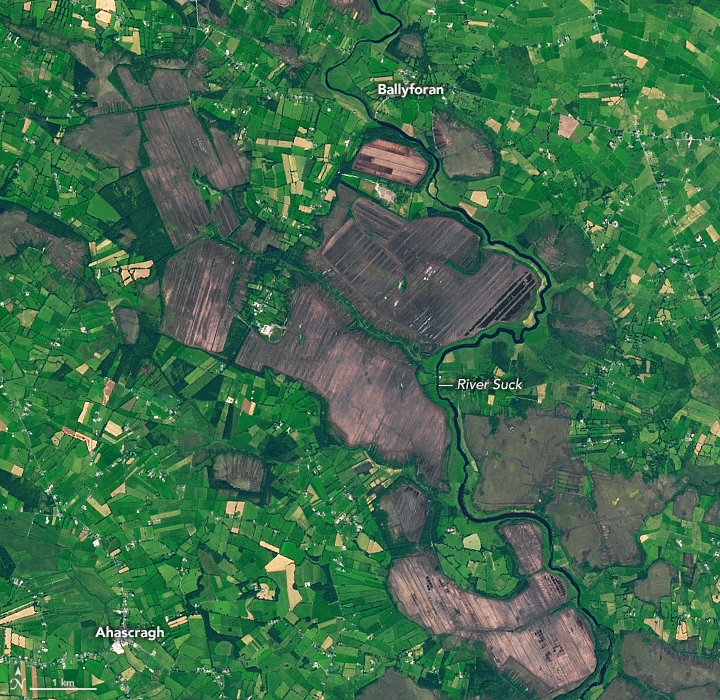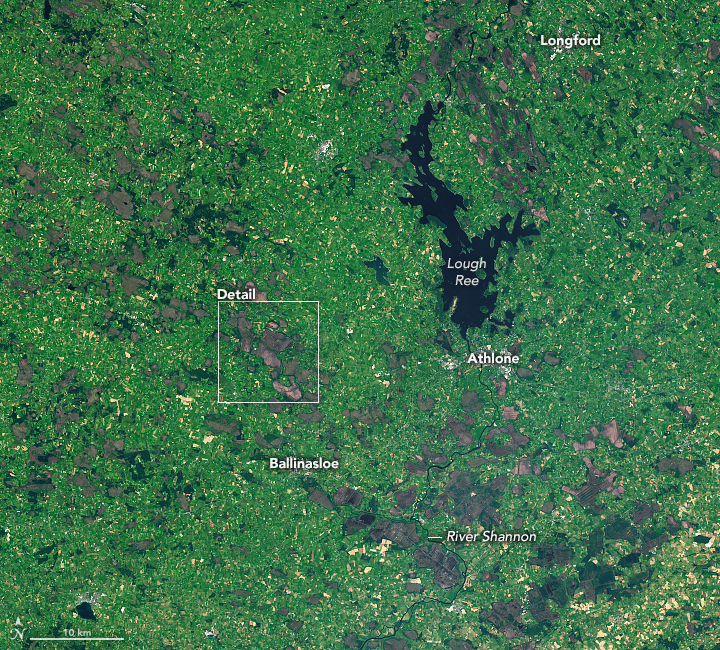
Ireland’s Cutaway Peatlands
Downloads
- peatireland_oli2_2022225.jpg (720x700, JPEG)
- peatireland_oli2_2022225_lrg.jpg (5115x4741, JPEG)
- peat_briquettes.jpg (720x540, JPEG)
Metadata
- Sensor(s):
- Landsat 9 - OLI-2
- Data Date: August 13, 2022
- Visualization Date: December 29, 2022
Peatlands are a quintessential part of Ireland’s green countryside and make up about one in every five hectares of land. For centuries, peat has been dug up and burned in Irish fireplaces, but concern for the climate is causing people to reconsider how peatlands are managed.
Peatlands are water-logged ecosystems that can store thousands of years of carbon in the depths of their soil. In the past, they have been thought of as unproductive land. Many countries encouraged the draining and cutting of peatland to gain economic value from the land. But we now know that these wet, mossy areas are one of Earth’s most important carbon sinks, storing more carbon than all of the trees in the world’s forests.
The image above shows an area of central Ireland, near Ballyforan, where multiple peat bogs have been dug up for fuel. It was acquired on August 13, 2022, by the Operational Land Imager-2 (OLI-2) on Landsat 9. Peat extraction involves draining the wetland of water and removing the green mossy cover before cutting into the peat. Lines in the soil show where peat has been cut to make turf briquettes used for heating homes. Some peat has historically been mined for use in power plants and some is used for horticulture.
"Draining and cutting peatlands turns them into brown deserts," said Florence Renou-Wilson, a research scientist at the University College Dublin. "It also releases all the carbon they have stored away." Much like how many people use wood in their fireplace, about 12 percent of households in Ireland occasionally use peat as an additional source of heat. Renou-Wilson noted this is because Ireland’s forests were already largely cut down by the end of the 19th century, and peat has been used as a cheap alternative to imported coal and natural gas.
Peat used to be cut by hand using a long knife called a sleán, but both domestic and industrial operations now use excavators or specialized machinery, noted Renou-Wilson. The peat cutting season typically starts around St. Patrick’s Day in March, and continues throughout the spring. The briquettes are left out to dry in the summer and then burned in homes over autumn and winter. Renou-Wilson shot the photo below in 2021, which shows peat briquettes drying in a field in Offaly.

Only about 20 percent of Ireland’s peatlands are still intact, according to Renou-Wilson’s research. She calls this remaining peat the country’s “last remaining wildlands,” because of their importance for carbon storage and biodiversity.
Concern about the carbon-intensity of peat extraction and use is changing how these wetlands are managed. In 2021, Ireland’s largest peat company announced a formal end to all peat mining operations, in an effort to decarbonize energy sources. Renou-Wilson is also working with Ireland’s Environmental Protection Agency to research how to protect intact wetlands, and rewet those that have been degraded, so that they can once again sequester carbon.
References & Resources
- Ireland Environmental Protection Agency (2022) Peatland Properties Influencing Greenhouse Gas Emissions and Removal. Accessed December 30, 2022.
- Irish Examiner (2021, January 15) Bord Na Móna ends peat harvesting in drive for greener energy production. Accessed December 30, 2022.
- UN Environment Programme Peatlands store twice as much carbon as all the world’s forests. Accessed December 30, 2022.
- Wilson, D., et al. (2022) Carbon and climate implications of rewetting a raised bog in Ireland. Global Change Biology, 28(21), 6349-6365.
NASA Earth Observatory images by Lauren Dauphin, using Landsat data from the U.S. Geological Survey. Photo of peat briquettes in Offaly, Ireland by Florence Renou-Wilson. Story by Emily Cassidy.
This image record originally appeared on the Earth Observatory. Click here to view the full, original record.
